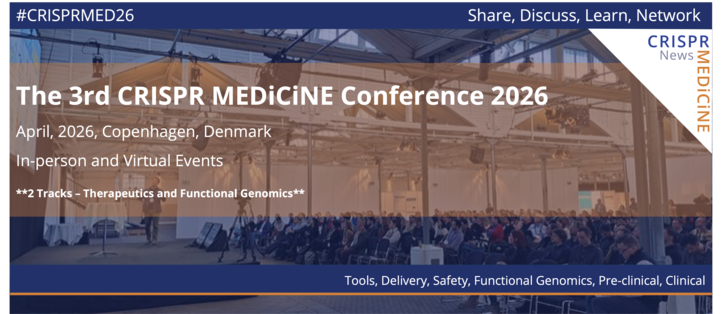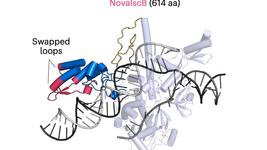CMN Weekly (26 May 2023) - Your Weekly CRISPR Medicine News
By: Gorm Palmgren - May. 26, 2023
Top picks
- In vivo epigenomic gene editing of the promoter of the PCSK9 gene has led to a stable change in the DNA methylation pattern, a ~75% drop in serum PCSK9 and a ~56% reduction in LDL-cholesterol levels in non-human primates. Tune Therapeutics announced the news last Friday at the 26th Annual Meeting of the American Society of Gene & Cell Therapy (ASGCT). The company used its TEMPO platform for the achievement. This versatile, modular platform incorporates a DNA-binding domain that binds to DNA without cutting it and is tethered to one or more effector proteins, which produce the required epigenetic effect.
- British scientists have used CRISPR to block the uptake of antimicrobial resistance (AMR) plasmids and to remove resident plasmids from Escherichia coli and in a range of environmental, pig- and human-associated coliform isolates. In vitro experiments, where the CRISPR tools were introduced to target bacteria by conjugation, demonstrated low conjugation efficiencies (~65% of target cells), while the AMR plasmid was removed in 99.98% of cells that were successfully conjugated.
Research
- Three new CRISPR gene editing systems that perform better than Cas9 are characterised by scientists at Metagenomi, California. The new CRISPR effector nucleases belong to type II (MG3-6 and a chimeric version MG3-6/4) and type V (MG29-1) and were sourced from the human microbiome and a hydrothermal vent, respectively. The authors find that all three systems can perform reproducible, high-frequency gene editing. e.g., disruption of the T cell receptor (TCR) alpha-chain was induced in >95% of cells, both paralogues of the TCR beta-chain in >90% of cells, and >90% knockout of β2-microglobulin, TIGIT, FAS, and PDCD1.
- A new TALEN-based method enables efficient strand-selective base editing of human mitochondrial DNA. CRISPR-based strategies are hampered by the difficulty of delivering guide RNAs into mitochondria, while DNA binding in TALEN relies on highly variable amino acid sequences without additional guides. Circular RNAs encoding the mitoBEs delivered the tools into patient-derived cells, enabling up to 77% base-editing efficiency and high specificity in various pathogenic mitochondrial DNA mutations.
- American scientists demonstrate CRISPR-based engineering of RNA viruses in a not-yet peer-reviewed paper. The authors combined sequence-specific VRISPR-based RNA cleavage with programmable RNA repair to make precise deletions and insertions in RNA. Approximately 5% of the bulk virus could be edited as intended.
- Danish and Chinese researchers have compared the efficiency of three different gene editing techniques for the correction of Duchenne Muscular Dystrophy (DMN) mutations: in-frame deletion, homology-directed repair (HDR), and prime editing (PE). They find that the highest editing efficiency was achieved by non-homologous blunt end joining (NHBEJ, 74-77%), followed by HDR (21-24%) and PE2 (1.5%) in HEK293T cells.
- A new versatile and efficient approach for precisely integrating large, gene-sized DNA fragments - LOCK - utilises specially designed 3'-overhang double-stranded DNA (odsDNA) donors harbouring 50-nt homology arm. LOCK allows highly efficient targeted insertion of kilobase-sized DNA fragments into the mammalian genomes with low cost and low off-target effects, yielding >fivefold higher knock-in frequencies than conventional homologous recombination-based approaches.
Industry
- Novo Nordisk and Life Edit Therapeutics will establish a multi-target collaboration to discover and develop gene editing therapies for rare and cardiometabolic diseases. Life Edit will receive an upfront cash payment and is eligible for milestone payments of 250-335 million US dollars for each of seven development programmes. In addition, Life Edit can have a global profit share on one programme.
Detection
- Chinese researchers have developed a CRISPR-Cas12a-based platform for the ultrasensitive, rapid, and highly specific detection of Mycobacterium tuberculosis in clinical applications. The platform utilises multiple cross-displacement amplification (MCDA) and has a detection limit of 40 fg per reaction.
- Spanish researchers have developed a multiplexable and biocomputational virus detection method by CRISPR-Cas9-mediated strand displacement. The strategy allows for the simultaneous detection of different DNA amplicons with the same nuclease to detect different SARS-CoV-2 regions or respiratory viruses.
Reviews
- Development of Single Molecule Techniques for Sensing and Manipulation of CRISPR and Polymerase Enzymes. This review discusses various techniques for sensing and manipulating single biomolecules that can help facilitate and expedite discoveries about the mechanisms of these enzymes and thereby significantly expand their use.
- The applications of CRISPR/Cas-mediated genome editing in genetic hearing loss. This review details the recent achievements of the CRISPR-Cas technique in disease modelling and therapeutic strategies for congenital hearing loss. Furthermore, it discusses the challenges of applying CRISPR-Cas techniques in future clinical treatments.
- Multiplexed CRISPR-based Methods for Pathogen Nucleic Acid Detection. This review covers the current state of multiplexed nucleic acid detection methods, focusing on CRISPR-based strategies. It also looks toward the future of multiplexed point-of-care diagnostics.
- A review on CRISPR/Cas: a versatile tool for cancer screening, diagnosis, and clinic treatment. This review discusses various CRISPR-Cas-derived genome and epigenome tools for cancer biology study and treatment and their efficiency and long term-safety. It also looks at developing new CRISPR-Cas delivery methods and reducing potential side effects, including off-target impacts in cancer-related research, diagnosis, and therapeutical treatment.
News from CRISPR Medicine News
- On Monday, we interviewed Eric Olson at the University of Texas Southwestern about his recent paper demonstrating the use of base editing to correct a common hypertrophic cardiomyopathy (HCM) mutation in patient-induced pluripotent stem cell-derived cardiomyocytes and a humanised mouse model.
To get more of the CRISPR Medicine News delivered to your inbox, sign up to the free weekly CMN Newsletter here.
Tags
CLINICAL TRIALS
Castration-Resistant Prostate Cancer, CRPC, and Salivary Gland Cancer, SGC, (NCT04249947)
Sponsors:
Poseida Therapeutics, Inc.
Sponsors:
Poseida Therapeutics, Inc.
IND Enabling
Phase I
Phase II
Phase III
IND Enabling
Phase I
Phase II
Phase III
IND Enabling
Phase I
Phase II
Phase III







